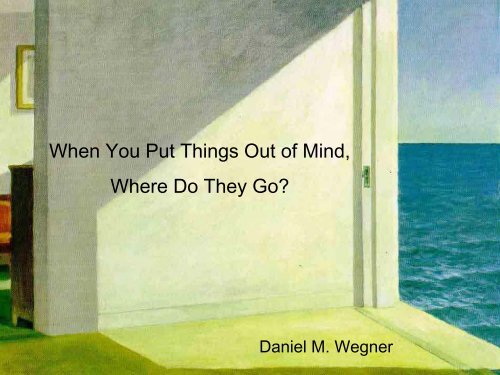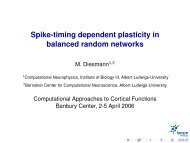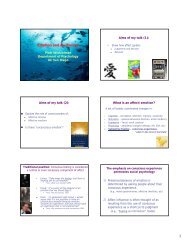When You Put Things Out of Mind, Where Do They Go? - The Swartz ...
When You Put Things Out of Mind, Where Do They Go? - The Swartz ...
When You Put Things Out of Mind, Where Do They Go? - The Swartz ...
- No tags were found...
Create successful ePaper yourself
Turn your PDF publications into a flip-book with our unique Google optimized e-Paper software.
<strong>When</strong> <strong>You</strong> <strong>Put</strong> <strong>Things</strong> <strong>Out</strong> <strong>of</strong> <strong>Mind</strong>,<strong>Where</strong> <strong>Do</strong> <strong><strong>The</strong>y</strong> <strong>Go</strong>?Daniel M. Wegner
Try to pose for yourself this task:not to think <strong>of</strong> a polar bear, and youwill see that the cursed thing willcome to mind every minute.Fyodor <strong>Do</strong>stoyevsky (1863)Winter Notes on Summer Impressions
ReboundBell Rings Per Minute65Post-suppression432101 2 3 4 5MinutePre-suppressionWegner, Schneider, Carter, & White (1987)
ChronicityPersonally Relevant Intrusive Thoughts <strong>Out</strong>side the LaboratoryMean number <strong>of</strong> thoughtsbetween meals over four days Mean rating <strong>of</strong> discomfort (0-100)2.0501.51.0403020SuppressThinkThroughRecord0.5100.00RecordThinkSuppressDay 1 Day 2 Day 3 Day 4ThroughTrinder & Salkovskis (1994)
Ironic Process <strong>The</strong>oryAn intentional operating processsearches for mental contents tocreate the desired mental state• Effortful• Conscious• InterruptibleAn ironic monitoring processsearches for mental contents thatsignal the failure <strong>of</strong> mental control• Automatic• Unconscious• UninterruptibleWegner (1994)
HyperaccessibilityColor-naming Reaction Times (msec)540530520510500490480470460NONTARGET WORDTARGET WORD450Suppress Think Suppress ThinkLow Load High LoadWegner, Erber, & Zanakos (1993)
PerceptionSeconds holding down key to report seeing target“Try not to see the duck” vs.Try to see the rabbit”Try to seeTry not to seeNo instruction0 60 120“Try not to see the cat” vs.Try to see the swan”Slesar & Mack (2005)
DeceptionInstruction: Identify the target object to the addresseePercentage <strong>of</strong> foil-contrastingmodifiers (e.g., “small triangle”)15105DifferentshapesSameshape0BaselineConcealLane, Groisman, & Ferreira (2006)
Brain ActivationTask blocks (6 functional runs, task order reversed for 3)• 120 sec Suppression with button press for white bear thought• 28 sec Manual response with button press at light onset• 120 sec Free thought with button press for white bear thoughtMitchell, Heatherton, Kelley, Wyland, Wegner, & Macrae (in press)
Right DLPFC: Sustained activation during suppression task
Bilateral ACC: Transient activation during suppression intrusionsLeftRight
DreamsWishes suppressed duringthe day assert themselves indreamsSigmund Freud (1900):<strong>The</strong> Interpretation<strong>of</strong> Dreams
Dream ReboundMean mentions <strong>of</strong> person in dream reportsTargetNontarget1.201.101.000.900.800.700.600.500.400.300.20Mention Expression SuppressionPre-Sleep Thought InstructionWegner, Wenzlaff, & Kozak (2004)
Asymmetric Reminding
Asymmetric RemindingPriming Asymmetry During SuppressionNajmi & Wegner (in press)
Asymmetric RemindingPriming Asymmetry During SuppressionNajmi & Wegner (in press)
Asymmetric RemindingPrime appears 50 msec before target lexical decisionSuppress: Mountain640620PrimeTarget600Reaction Time (ms)580560540520500Focus Mountain word toassociateAssociate Climbt<strong>of</strong>ocus wordClimbMountain480460Low LoadHigh LoadNajmi & Wegner (in press)
Psychopathology
PsychopathologyFollowing instructions to suppress relevant thoughts:• Increases thoughts <strong>of</strong> smoking during quitting (Toll, Sobell, Wagner,& Sobell, 2001)• Increases fear <strong>of</strong> dentists (Muris, Jongh, Merckelbach, Postema, &Vet, 1998)• Reduces immune response (Petrie, Booth, & Pennebaker, 1998)• Increases distress in rape survivors suffering from PTSD (Shipherd& Beck, 1999)
PsychopathologyDispositional thought suppression predicts:• Depression, anxiety, and obsessive-compulsive disorder (Wegner &Zanakos, 1994)• Poor coping in accident victims (Aaron, Zaglul, & Emery, 1999)• Dissociative memory experiences (Muris & Merkelbach, 1997)• Intentional self-injury in adolescents (Najmi, Wegner, & Nock, inpress)
<strong>When</strong> you put things out <strong>of</strong> mind, they never really leave
With thanks to…• Sam Carter, Ralph Erber, Todd Heatherton, Bill Kelley,Meg Kozak, Neil Macrae, Jason Mitchell, Sadia Najmi,Dave Schneider, Rich Wenzlaff, Teri White, CarrieWyland, Sophia Zanakos• National Institute <strong>of</strong> Mental Health• National Science Foundationwww.wjh.harvard.edu/~wegner








